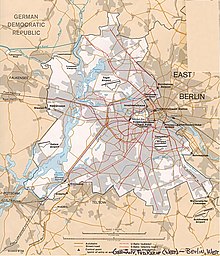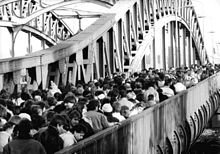Border crossing at Bornholmer Strasse



The Bornholmer Strasse border crossing was a border crossing on the Berlin Wall from 1961 to 1990; it connected the districts of Prenzlauer Berg and Wedding in the north of Berlin via the Bösebrücke .
Naming and origin
It gets its name from its location on Bornholmer Strasse , which - named in 1903 after the Danish island of Bornholm in the Baltic Sea - runs through the former districts of Prenzlauer Berg and Wedding (now parts of the districts of Pankow and Mitte , district of Gesundbrunnen ). Bornholmer Straße is part of the outer ring road from the Berlin development plan from 1862.
November 9, 1989
According to Günter Schabowski's statement, broadcast live, at a press conference on November 9, 1989 , a Thursday at around 7 p.m., that GDR citizens would be given the freedom to travel, to which he added on request that the regulations were to apply “immediately” The Bornholmer Strasse border crossing was the first border crossing in Berlin, at which passport controls were suspended at 11:30 p.m. and through which thousands of GDR citizens took the opportunity to come to West Berlin for the first time:
In the course of the evening, according to Schabowki's declaration, more and more GDR citizens gathered at the border crossing to get to West Berlin. The head of the Bornholmer Strasse border crossing, Lieutenant Colonel Harald Jäger , kept asking his superiors how to proceed, but received no or meaningless instructions from them. After the triggering of a "silent" (outwardly imperceptible) alarm, the superiors reacted for the first and last time: The instruction came (from around 9:20 pm) to allow individual people (namely "the biggest screamers") to leave the country . The GDR identity card was stamped halfway over the photo. This was intended to prevent re-entry into the GDR - but the people were not informed about this.
However, it turned out that this did not solve the problem: More and more GDR citizens crowded in front of the border crossing and demanded that they leave the country. The situation worsened on site. Left alone by his superiors, Harald Jäger, on the one hand under the pressure of the circumstances, on the other hand apparently angry about the behavior of the superiors and resigned to the problem, left them on November 9, 1989 after another two hours at 11:29 p.m. on his own initiative and contrary to the orders Open the border crossing point and stop all passport controls. The crossing became the first place where the Berlin Wall was opened. The up to then almost 1,000 willing travelers who had gathered at the border crossing point were allowed to travel to the West.
After Harald Jäger had informed the MfS headquarters that he had opened the barriers, the other six border crossings received instructions from there around midnight to proceed in the same way.
Commemoration
On the first anniversary of the fall of the Berlin Wall, a memorial stone was erected east of the bridge on the site of the former border crossing point. This is made from a wall segment. His inscription reads:
“On the night of November 9-10, 1989, the wall opened on the Bornholmer Strasse bridge for the first time since August 1961. The Berliners got together again. Willy Brandt : 'Berlin will live and the wall will fall.' "
In the western truss of the Bösebrücke there is a memorial plaque with the inscription
"Bösebrücke 1961–1989 GDR border crossing / was the first crossing of the inner-German border on November 9, 1989, at which the GDR border barriers fell."
Every November 9th, Berlin citizens and the two mayors of the city districts of Mitte and Pankow gather at the Bösebrücke in the evening hours to remember the events of 1989 with a glass of sparkling wine.
In the TV film Bornholmer Straße from 2014, which is not entirely true to the facts (in which, for example, the main characters sometimes have different names than the historical figures), the events of this evening form the main dramatic motif.
In the film Once Ku'damm and Back , the Bornholmer Strasse border crossing gained fame through the arrest of the head chef of the Swiss embassy, Peter Gross . Harald Jäger , then lieutenant colonel, was ordered by the Stasi to control the car and make an arrest because the assumption was that in the trunk of a female person is.
Surroundings
Below the bridge is the Bornholmer Strasse station of the Berlin S-Bahn , which from 1961 to 1990 is assigned to the ghost stations in Berlin in the broader sense . After the German reunification, there was a temporary car dealership on the site of the former border crossing . After the site was sold to an investor, a supermarket was built on the site in mid-2011.
A section of the Berlin Wall Trail with a small avenue of Japanese ornamental cherries now runs on the former wall strip below the Bösebrücke . These trees are a gift from the Sakura-Campaign fundraising campaign run by a Japanese TV station as an expression of the great sympathy for the events of German reunification. The Japanese wanted the ornamental cherries to bring peace and tranquility to the hearts of Berliners.
On November 9, 2010, on the eastern side of the Bösebrücke north of Bornholmer Strasse, the place of 9 November 1989 was inaugurated, on which a picture gallery with photos of the opening of the wall can be seen, with which the history of the border crossing on the Bösebrücke is remembered. The financing came from the assets of the parties and mass organizations of the former GDR. This place is not a place in the urban planning sense because there are no buildings on it. Rather, it is a narrow, approximately 200-meter-long site next to Bornholmer Strasse, which is bounded by the former hinterland security wall that still exists. From this, rusting steel strips run through the floor covering at irregular intervals. The events of November 9, 1989 are chronologically remembered. The memorial stone made from a segment of the wall was moved from the site of the former border crossing point to the newly designed area. The square is planted with a special cultivation of Japanese ornamental cherries, which bloom in spring, but also in November in mild weather.
Media reception
- Bornholmer Straße (film) , tragic comedy by director Christian Schwochow from 2014 about the events at the Bornholmer Straße border crossing on November 9, 1989.
Web links
- Bornholmer Straße - transit area of German unity . In: Wirtschaftswoche , November 9, 2009
- Representation of the former border crossing on Bornholmer Strasse on berlin.de
- Border crossing on Bornholmer Strasse on www.chronik-der-mauer.de
Individual evidence
- ↑ November 9th . On: Mirror DVD
- ↑ Gerhard Haase-Hindenberg: The man who opened the wall. Wilhelm Heyne Verlag, Munich 2007, ISBN 978-3-453-62025-4 , pp. 202-205.
- ^ Press conference and quotations from Hans-Hermann Hertle : Chronicle of the fall of the wall , also chronicle of the wall: November 9, 1989.
- ^ Bornholmer Strasse - The incredible, but true story of Lieutenant Colonel Harald Schäfer. ARD .de, accessed on November 5, 2014
- ↑ Horst Bosetzky: The perception of the ghost stations in West Berlin. In: Gerhard Sälters, Tina Schaller (eds.): Border and ghost stations in divided Berlin. Christoph Links Verlag, Berlin 2013, ISBN 978-3-86153-723-6 , p. 81.
- ↑ Information about the Platz des November 9, 1989 ( memento from April 15, 2010 in the Internet Archive ) at www.berlin.de, accessed on April 23, 2010
- ↑ Wowereit hands over new memorial site . In: Der Tagesspiegel , November 9, 2010, accessed on November 10, 2010
Coordinates: 52 ° 33 ′ 17 ″ N , 13 ° 23 ′ 55 ″ E


